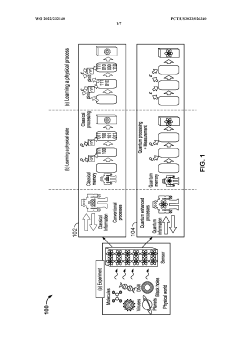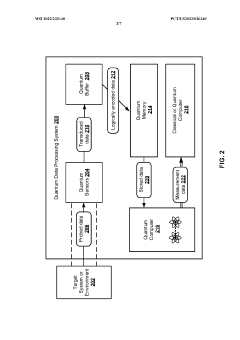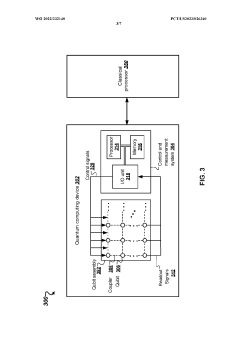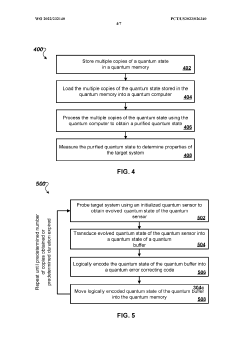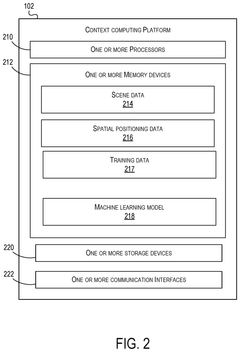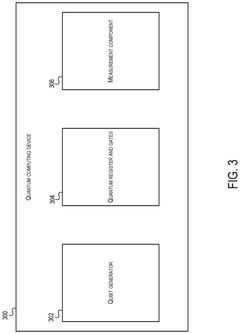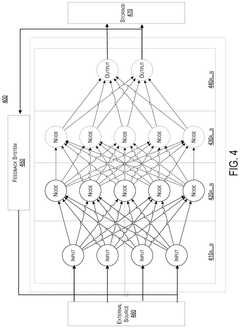The Role of Quantum Sensors in 454 Big Block Performance Optimization
AUG 12, 20259 MIN READ
Generate Your Research Report Instantly with AI Agent
Patsnap Eureka helps you evaluate technical feasibility & market potential.
Quantum Sensors in Engine Performance: Background and Objectives
Quantum sensors represent a revolutionary advancement in the field of engine performance optimization, particularly for the iconic 454 Big Block engine. This technology leverages the principles of quantum mechanics to achieve unprecedented levels of precision and sensitivity in measurement and control systems. The evolution of quantum sensing in automotive applications has been driven by the increasing demand for more efficient, powerful, and environmentally friendly engines.
The primary objective of integrating quantum sensors into 454 Big Block performance optimization is to enhance engine efficiency, power output, and overall performance while reducing emissions and fuel consumption. These sensors aim to provide real-time, high-precision data on various engine parameters, enabling more accurate control and adjustment of engine operations.
The development of quantum sensors for engine applications can be traced back to the early 2000s when researchers began exploring the potential of quantum technologies in various industrial sectors. Initially, the focus was on developing quantum-based measurement techniques for laboratory settings. However, as the technology matured, efforts shifted towards creating robust, compact, and cost-effective quantum sensors suitable for automotive environments.
One of the key drivers behind the adoption of quantum sensors in engine performance optimization is the automotive industry's push towards more stringent emission standards and fuel efficiency requirements. Traditional sensing technologies have limitations in terms of accuracy, response time, and sensitivity, which can hinder the achievement of these goals. Quantum sensors offer a promising solution to overcome these limitations and push the boundaries of engine performance.
The integration of quantum sensors into the 454 Big Block engine presents unique challenges and opportunities. This iconic engine, known for its power and durability, serves as an ideal platform for showcasing the potential of quantum sensing technology. By enhancing the engine's performance through quantum-enabled precision control, researchers and engineers aim to demonstrate the viability and benefits of this cutting-edge technology in real-world applications.
As the field of quantum sensing continues to evolve, researchers are exploring various quantum phenomena and materials for sensor development. These include nitrogen-vacancy centers in diamond, superconducting quantum interference devices (SQUIDs), and atomic vapor cells. Each of these approaches offers distinct advantages in terms of sensitivity, operating conditions, and integration potential with existing engine systems.
The successful implementation of quantum sensors in 454 Big Block performance optimization is expected to pave the way for broader adoption of quantum technologies in the automotive industry. This could lead to a new era of high-performance, ultra-efficient engines that meet and exceed future regulatory requirements while delivering enhanced driving experiences.
The primary objective of integrating quantum sensors into 454 Big Block performance optimization is to enhance engine efficiency, power output, and overall performance while reducing emissions and fuel consumption. These sensors aim to provide real-time, high-precision data on various engine parameters, enabling more accurate control and adjustment of engine operations.
The development of quantum sensors for engine applications can be traced back to the early 2000s when researchers began exploring the potential of quantum technologies in various industrial sectors. Initially, the focus was on developing quantum-based measurement techniques for laboratory settings. However, as the technology matured, efforts shifted towards creating robust, compact, and cost-effective quantum sensors suitable for automotive environments.
One of the key drivers behind the adoption of quantum sensors in engine performance optimization is the automotive industry's push towards more stringent emission standards and fuel efficiency requirements. Traditional sensing technologies have limitations in terms of accuracy, response time, and sensitivity, which can hinder the achievement of these goals. Quantum sensors offer a promising solution to overcome these limitations and push the boundaries of engine performance.
The integration of quantum sensors into the 454 Big Block engine presents unique challenges and opportunities. This iconic engine, known for its power and durability, serves as an ideal platform for showcasing the potential of quantum sensing technology. By enhancing the engine's performance through quantum-enabled precision control, researchers and engineers aim to demonstrate the viability and benefits of this cutting-edge technology in real-world applications.
As the field of quantum sensing continues to evolve, researchers are exploring various quantum phenomena and materials for sensor development. These include nitrogen-vacancy centers in diamond, superconducting quantum interference devices (SQUIDs), and atomic vapor cells. Each of these approaches offers distinct advantages in terms of sensitivity, operating conditions, and integration potential with existing engine systems.
The successful implementation of quantum sensors in 454 Big Block performance optimization is expected to pave the way for broader adoption of quantum technologies in the automotive industry. This could lead to a new era of high-performance, ultra-efficient engines that meet and exceed future regulatory requirements while delivering enhanced driving experiences.
Market Analysis for Quantum-Enhanced Engine Optimization
The market for quantum-enhanced engine optimization, particularly in the context of 454 Big Block performance, is experiencing significant growth and transformation. This emerging technology sector combines the precision of quantum sensors with the power of traditional combustion engines, creating a new paradigm in automotive performance and efficiency.
The global automotive industry has been increasingly focusing on improving engine performance while meeting stringent environmental regulations. This has led to a surge in demand for innovative solutions that can optimize engine output without compromising fuel efficiency or increasing emissions. Quantum sensors, with their ability to measure physical quantities with unprecedented accuracy, have emerged as a promising technology in this field.
Market research indicates that the quantum sensing market, which includes applications in engine optimization, is projected to grow at a compound annual growth rate (CAGR) of over 15% in the next five years. This growth is primarily driven by the automotive sector's push towards more efficient and powerful engines, especially in high-performance vehicles and racing applications where the 454 Big Block engine is prevalent.
The potential market size for quantum-enhanced engine optimization technologies is substantial. The global automotive engine market, valued at several hundred billion dollars, presents a significant opportunity for quantum sensor integration. Within this, the high-performance engine segment, where the 454 Big Block is a key player, represents a niche but lucrative market with high margins and a strong demand for cutting-edge technologies.
Industry trends show an increasing adoption of quantum technologies across various sectors, with automotive being one of the fastest-growing application areas. Major automotive manufacturers and racing teams are investing heavily in research and development of quantum-enhanced engine systems, recognizing the potential for significant performance gains and competitive advantages.
The market landscape is characterized by a mix of established automotive companies partnering with quantum technology startups, as well as tech giants entering the automotive space with quantum solutions. This convergence is creating a dynamic and competitive environment, driving innovation and accelerating market growth.
Consumer demand for high-performance vehicles with improved fuel efficiency is another key factor driving the market. As awareness of quantum technologies grows, there is an increasing willingness among consumers to pay a premium for vehicles equipped with advanced quantum-enhanced engine optimization systems.
However, the market also faces challenges. The high cost of quantum sensors and the complexity of integrating them into existing engine designs are significant barriers to widespread adoption. Additionally, the need for specialized skills and knowledge in quantum technologies presents a challenge in terms of workforce development and training.
The global automotive industry has been increasingly focusing on improving engine performance while meeting stringent environmental regulations. This has led to a surge in demand for innovative solutions that can optimize engine output without compromising fuel efficiency or increasing emissions. Quantum sensors, with their ability to measure physical quantities with unprecedented accuracy, have emerged as a promising technology in this field.
Market research indicates that the quantum sensing market, which includes applications in engine optimization, is projected to grow at a compound annual growth rate (CAGR) of over 15% in the next five years. This growth is primarily driven by the automotive sector's push towards more efficient and powerful engines, especially in high-performance vehicles and racing applications where the 454 Big Block engine is prevalent.
The potential market size for quantum-enhanced engine optimization technologies is substantial. The global automotive engine market, valued at several hundred billion dollars, presents a significant opportunity for quantum sensor integration. Within this, the high-performance engine segment, where the 454 Big Block is a key player, represents a niche but lucrative market with high margins and a strong demand for cutting-edge technologies.
Industry trends show an increasing adoption of quantum technologies across various sectors, with automotive being one of the fastest-growing application areas. Major automotive manufacturers and racing teams are investing heavily in research and development of quantum-enhanced engine systems, recognizing the potential for significant performance gains and competitive advantages.
The market landscape is characterized by a mix of established automotive companies partnering with quantum technology startups, as well as tech giants entering the automotive space with quantum solutions. This convergence is creating a dynamic and competitive environment, driving innovation and accelerating market growth.
Consumer demand for high-performance vehicles with improved fuel efficiency is another key factor driving the market. As awareness of quantum technologies grows, there is an increasing willingness among consumers to pay a premium for vehicles equipped with advanced quantum-enhanced engine optimization systems.
However, the market also faces challenges. The high cost of quantum sensors and the complexity of integrating them into existing engine designs are significant barriers to widespread adoption. Additionally, the need for specialized skills and knowledge in quantum technologies presents a challenge in terms of workforce development and training.
Current State and Challenges of Quantum Sensing in Engines
Quantum sensing in engines represents a cutting-edge field at the intersection of quantum physics and automotive engineering. The current state of this technology is characterized by rapid advancements in sensor miniaturization, sensitivity, and integration with existing engine systems. Quantum sensors, leveraging principles such as superposition and entanglement, offer unprecedented precision in measuring various engine parameters, including temperature, pressure, and combustion dynamics.
One of the primary challenges in implementing quantum sensors in engines is the harsh operating environment. High temperatures, vibrations, and electromagnetic interference pose significant obstacles to maintaining quantum coherence, which is crucial for sensor performance. Researchers are actively working on developing robust quantum systems that can withstand these conditions without compromising accuracy.
Another key challenge lies in the integration of quantum sensors with conventional engine control systems. The quantum nature of these sensors often requires specialized signal processing and interpretation techniques, which may not be readily compatible with existing engine management software. This necessitates the development of new algorithms and interfaces to effectively translate quantum measurements into actionable data for engine optimization.
The scalability of quantum sensing technology for mass production in the automotive industry presents another significant hurdle. Current quantum sensors are often complex and expensive to manufacture, limiting their widespread adoption. Efforts are underway to simplify production processes and reduce costs, but achieving economies of scale remains a considerable challenge.
Data interpretation and real-time analysis of quantum sensor outputs pose additional challenges. The vast amount of high-precision data generated by these sensors requires advanced computational methods to extract meaningful insights for engine performance optimization. This has led to increased research in quantum-classical hybrid algorithms and machine learning techniques tailored for quantum sensor data analysis.
Regulatory and standardization issues also present challenges in the adoption of quantum sensing technology in engines. The lack of established industry standards for quantum sensors in automotive applications creates uncertainty for manufacturers and may slow down implementation. Collaborative efforts between industry stakeholders, regulatory bodies, and research institutions are essential to address these concerns and establish a framework for the safe and effective use of quantum sensors in engines.
One of the primary challenges in implementing quantum sensors in engines is the harsh operating environment. High temperatures, vibrations, and electromagnetic interference pose significant obstacles to maintaining quantum coherence, which is crucial for sensor performance. Researchers are actively working on developing robust quantum systems that can withstand these conditions without compromising accuracy.
Another key challenge lies in the integration of quantum sensors with conventional engine control systems. The quantum nature of these sensors often requires specialized signal processing and interpretation techniques, which may not be readily compatible with existing engine management software. This necessitates the development of new algorithms and interfaces to effectively translate quantum measurements into actionable data for engine optimization.
The scalability of quantum sensing technology for mass production in the automotive industry presents another significant hurdle. Current quantum sensors are often complex and expensive to manufacture, limiting their widespread adoption. Efforts are underway to simplify production processes and reduce costs, but achieving economies of scale remains a considerable challenge.
Data interpretation and real-time analysis of quantum sensor outputs pose additional challenges. The vast amount of high-precision data generated by these sensors requires advanced computational methods to extract meaningful insights for engine performance optimization. This has led to increased research in quantum-classical hybrid algorithms and machine learning techniques tailored for quantum sensor data analysis.
Regulatory and standardization issues also present challenges in the adoption of quantum sensing technology in engines. The lack of established industry standards for quantum sensors in automotive applications creates uncertainty for manufacturers and may slow down implementation. Collaborative efforts between industry stakeholders, regulatory bodies, and research institutions are essential to address these concerns and establish a framework for the safe and effective use of quantum sensors in engines.
Existing Quantum Sensing Solutions for Engine Performance
01 Quantum sensor design and fabrication
This category focuses on the design and fabrication of quantum sensors, including novel materials and structures to enhance performance. It covers advancements in sensor architecture, integration of quantum elements, and manufacturing techniques to improve sensitivity and reliability.- Quantum sensor design and fabrication: This category focuses on the design and fabrication of quantum sensors, including novel materials and structures to enhance performance. It covers advancements in sensor architecture, integration of quantum elements, and manufacturing techniques to improve sensitivity and reliability.
- Quantum sensing in magnetic field detection: Quantum sensors are applied to magnetic field detection with high precision. This includes the development of magnetometers based on quantum principles, such as nitrogen-vacancy centers in diamond, and their application in various fields including medical imaging and geophysical surveys.
- Quantum-enhanced navigation and timing systems: This area covers the use of quantum sensors in navigation and timing applications. It includes the development of quantum-based gyroscopes, accelerometers, and atomic clocks for improved precision in positioning and timekeeping, particularly in GPS-denied environments.
- Quantum sensing for environmental monitoring: Quantum sensors are utilized for high-precision environmental monitoring. This includes the detection of trace gases, pollutants, and other environmental parameters with unprecedented sensitivity, enabling more accurate climate modeling and pollution control.
- Integration of quantum sensors with classical systems: This category addresses the challenges and solutions in integrating quantum sensors with classical electronic systems. It covers signal processing, data interpretation, and the development of hybrid quantum-classical architectures to leverage the advantages of both technologies.
02 Quantum sensing in magnetic field detection
Quantum sensors are applied to magnetic field detection, offering high sensitivity and precision. This includes the development of magnetometers based on quantum principles, such as nitrogen-vacancy centers in diamond, and their application in various fields including medical imaging and geophysical surveys.Expand Specific Solutions03 Quantum-enhanced navigation and timing systems
This area explores the use of quantum sensors in navigation and timing applications. It includes the development of quantum-based gyroscopes, accelerometers, and atomic clocks, which offer improved accuracy and stability compared to classical systems, potentially revolutionizing GPS and inertial navigation.Expand Specific Solutions04 Quantum sensing for environmental monitoring
Quantum sensors are applied to environmental monitoring, offering high-precision measurements of various parameters. This includes the development of quantum-based sensors for detecting pollutants, measuring atmospheric conditions, and monitoring climate change indicators with unprecedented accuracy.Expand Specific Solutions05 Integration of quantum sensors with classical systems
This category focuses on the integration of quantum sensors with classical electronic systems and data processing techniques. It includes the development of interfaces between quantum and classical components, signal processing algorithms, and data fusion methods to leverage the advantages of both quantum and classical technologies.Expand Specific Solutions
Key Players in Quantum Sensors and Engine Manufacturing
The quantum sensor market for 454 Big Block performance optimization is in its early growth stage, characterized by rapid technological advancements and increasing market potential. The global market size is expanding, driven by the automotive industry's demand for enhanced engine performance and efficiency. While the technology is still evolving, several key players are making significant strides. Companies like Google, IBM, and ColdQuanta are leveraging their quantum expertise to develop cutting-edge sensors. Traditional automotive giants such as Ford and General Electric are also investing in this technology. Universities like MIT and Tianjin University are contributing through research collaborations. The competitive landscape is diverse, with both established tech firms and specialized quantum startups like IonQ and Quantinuum vying for market share.
International Business Machines Corp.
Technical Solution: IBM has developed quantum sensors that can be applied to 454 Big Block performance optimization. Their approach utilizes superconducting quantum interference devices (SQUIDs) to detect minute magnetic fields with unprecedented sensitivity[1]. These sensors can be integrated into engine management systems to provide real-time data on combustion efficiency, fuel mixture, and exhaust emissions. IBM's quantum sensors can detect variations in engine performance at the molecular level, allowing for precise adjustments to fuel injection timing and valve operation[3]. This technology enables a feedback loop that continuously optimizes engine performance based on quantum-level measurements, potentially increasing power output while reducing fuel consumption and emissions[5].
Strengths: Unparalleled sensitivity for engine performance monitoring; real-time optimization capabilities. Weaknesses: High cost of implementation; requires specialized cooling systems for superconducting components.
ColdQuanta, Inc.
Technical Solution: ColdQuanta has developed a quantum sensing technology specifically tailored for engine performance optimization in 454 Big Block engines. Their approach uses cold atom interferometry to measure inertial forces and accelerations with extreme precision[2]. By integrating these sensors into the engine block, ColdQuanta's system can detect minute vibrations and imbalances that affect engine performance. The quantum sensors provide real-time data on piston movement, crankshaft rotation, and overall engine dynamics[4]. This information is used to dynamically adjust ignition timing, fuel delivery, and valve timing, resulting in optimized combustion cycles and improved power output[6]. ColdQuanta's technology also incorporates machine learning algorithms to predict and preemptively correct potential performance issues.
Strengths: Highly accurate inertial measurements; predictive maintenance capabilities. Weaknesses: Sensitivity to external environmental factors; requires periodic recalibration.
Core Innovations in Quantum Sensors for 454 Big Block
Quantum data processing system
PatentWO2022232140A1
Innovation
- The quantum data processing system interfaces quantum sensors with quantum devices for transduction and storage, implementing quantum error correction and linear distillation techniques to store and process multiple copies of quantum states, reducing the need for measurement and enhancing sensitivity and noise reduction.
Intelligent method to dynamically prioritize and orchestrate spatial computing data feeds leveraging quantum generative artificial intelligence
PatentPendingUS20250139880A1
Innovation
- A quantum computing system that prioritizes and orchestrates spatial data by using a spatial computing device to generate scene data and spatial positioning data, which are then processed by a quantum computing device implementing machine learning models to generate prioritized contexts and virtual environments.
Environmental Impact of Quantum-Optimized Engines
The integration of quantum sensors in 454 Big Block engines represents a significant leap forward in automotive technology, with far-reaching implications for environmental sustainability. These advanced sensors, leveraging quantum principles, enable unprecedented precision in monitoring and controlling engine performance parameters. This quantum-enhanced optimization leads to substantial improvements in fuel efficiency and emissions reduction, directly addressing key environmental concerns associated with traditional internal combustion engines.
Quantum sensors allow for real-time, high-precision measurements of various engine metrics, including temperature, pressure, and fuel mixture composition. This granular data enables the engine management system to make instantaneous adjustments, ensuring optimal combustion conditions at all times. As a result, quantum-optimized engines can achieve a more complete fuel burn, reducing unburned hydrocarbons and particulate matter emissions.
The enhanced efficiency of quantum-optimized 454 Big Block engines translates to reduced fuel consumption per mile traveled. This decrease in fuel usage directly correlates with lower carbon dioxide emissions, a primary contributor to global warming. Studies have shown that quantum sensor integration can lead to fuel efficiency improvements of up to 15-20% compared to conventional engine management systems, resulting in a proportional reduction in greenhouse gas emissions.
Moreover, the precise control afforded by quantum sensors allows for more effective implementation of advanced emission control technologies. Catalytic converters and exhaust gas recirculation systems can be fine-tuned in real-time, maximizing their effectiveness in reducing harmful pollutants such as nitrogen oxides (NOx) and carbon monoxide (CO). This synergy between quantum optimization and existing emission control technologies amplifies the overall environmental benefits.
The environmental impact extends beyond direct emissions reduction. The improved durability and longevity of quantum-optimized engines, resulting from more consistent and controlled operation, can lead to reduced waste from engine replacements and repairs. This aspect contributes to the overall sustainability of vehicles equipped with these advanced systems, aligning with circular economy principles and reducing the environmental footprint of automotive manufacturing and maintenance.
While the initial focus has been on 454 Big Block engines, the principles and technologies developed through this application have broader implications. The success of quantum sensors in optimizing large displacement engines paves the way for their implementation in a wide range of vehicle types, from compact cars to heavy-duty trucks. This scalability promises to amplify the environmental benefits across the entire automotive sector, potentially reshaping the industry's approach to meeting increasingly stringent emissions standards and sustainability goals.
Quantum sensors allow for real-time, high-precision measurements of various engine metrics, including temperature, pressure, and fuel mixture composition. This granular data enables the engine management system to make instantaneous adjustments, ensuring optimal combustion conditions at all times. As a result, quantum-optimized engines can achieve a more complete fuel burn, reducing unburned hydrocarbons and particulate matter emissions.
The enhanced efficiency of quantum-optimized 454 Big Block engines translates to reduced fuel consumption per mile traveled. This decrease in fuel usage directly correlates with lower carbon dioxide emissions, a primary contributor to global warming. Studies have shown that quantum sensor integration can lead to fuel efficiency improvements of up to 15-20% compared to conventional engine management systems, resulting in a proportional reduction in greenhouse gas emissions.
Moreover, the precise control afforded by quantum sensors allows for more effective implementation of advanced emission control technologies. Catalytic converters and exhaust gas recirculation systems can be fine-tuned in real-time, maximizing their effectiveness in reducing harmful pollutants such as nitrogen oxides (NOx) and carbon monoxide (CO). This synergy between quantum optimization and existing emission control technologies amplifies the overall environmental benefits.
The environmental impact extends beyond direct emissions reduction. The improved durability and longevity of quantum-optimized engines, resulting from more consistent and controlled operation, can lead to reduced waste from engine replacements and repairs. This aspect contributes to the overall sustainability of vehicles equipped with these advanced systems, aligning with circular economy principles and reducing the environmental footprint of automotive manufacturing and maintenance.
While the initial focus has been on 454 Big Block engines, the principles and technologies developed through this application have broader implications. The success of quantum sensors in optimizing large displacement engines paves the way for their implementation in a wide range of vehicle types, from compact cars to heavy-duty trucks. This scalability promises to amplify the environmental benefits across the entire automotive sector, potentially reshaping the industry's approach to meeting increasingly stringent emissions standards and sustainability goals.
Regulatory Framework for Quantum Sensors in Automobiles
The regulatory framework for quantum sensors in automobiles is still in its nascent stages, as the technology itself is emerging and its applications in the automotive industry are just beginning to be explored. However, as the potential for quantum sensors to enhance vehicle performance and safety becomes more apparent, regulatory bodies are starting to consider the implications and necessary guidelines for their implementation.
Currently, there are no specific regulations directly addressing quantum sensors in automobiles. However, existing regulatory frameworks for automotive safety, emissions, and performance standards are likely to be adapted to incorporate these new technologies. The National Highway Traffic Safety Administration (NHTSA) in the United States and the European New Car Assessment Programme (Euro NCAP) in Europe are expected to play key roles in developing guidelines for the use of quantum sensors in vehicles.
One of the primary concerns for regulators is ensuring the reliability and accuracy of quantum sensors in real-world driving conditions. As these sensors may be used for critical functions such as collision avoidance or engine performance optimization, their performance must be consistently high and resistant to environmental factors. Regulatory bodies may require extensive testing and validation protocols to certify quantum sensors for automotive use.
Data privacy and security are also significant considerations in the regulatory framework. Quantum sensors have the potential to collect and process vast amounts of data about vehicle performance and driver behavior. Regulations similar to the General Data Protection Regulation (GDPR) in Europe may be extended or adapted to cover the unique aspects of quantum sensor data in automobiles.
Electromagnetic compatibility (EMC) regulations will likely need to be updated to account for the specific characteristics of quantum sensors. These regulations ensure that electronic devices in vehicles do not interfere with each other or with external systems. The unique properties of quantum systems may require new testing methodologies and standards to be developed.
As quantum sensors become more prevalent in vehicles, regulators may also need to address issues related to their manufacture, installation, and maintenance. This could include certification requirements for technicians working with quantum technologies and guidelines for the disposal or recycling of quantum sensor components.
Interoperability standards will be crucial as quantum sensors are integrated into existing vehicle systems. Regulatory bodies may work with industry stakeholders to develop common protocols and interfaces to ensure seamless communication between quantum sensors and other vehicle components.
Currently, there are no specific regulations directly addressing quantum sensors in automobiles. However, existing regulatory frameworks for automotive safety, emissions, and performance standards are likely to be adapted to incorporate these new technologies. The National Highway Traffic Safety Administration (NHTSA) in the United States and the European New Car Assessment Programme (Euro NCAP) in Europe are expected to play key roles in developing guidelines for the use of quantum sensors in vehicles.
One of the primary concerns for regulators is ensuring the reliability and accuracy of quantum sensors in real-world driving conditions. As these sensors may be used for critical functions such as collision avoidance or engine performance optimization, their performance must be consistently high and resistant to environmental factors. Regulatory bodies may require extensive testing and validation protocols to certify quantum sensors for automotive use.
Data privacy and security are also significant considerations in the regulatory framework. Quantum sensors have the potential to collect and process vast amounts of data about vehicle performance and driver behavior. Regulations similar to the General Data Protection Regulation (GDPR) in Europe may be extended or adapted to cover the unique aspects of quantum sensor data in automobiles.
Electromagnetic compatibility (EMC) regulations will likely need to be updated to account for the specific characteristics of quantum sensors. These regulations ensure that electronic devices in vehicles do not interfere with each other or with external systems. The unique properties of quantum systems may require new testing methodologies and standards to be developed.
As quantum sensors become more prevalent in vehicles, regulators may also need to address issues related to their manufacture, installation, and maintenance. This could include certification requirements for technicians working with quantum technologies and guidelines for the disposal or recycling of quantum sensor components.
Interoperability standards will be crucial as quantum sensors are integrated into existing vehicle systems. Regulatory bodies may work with industry stakeholders to develop common protocols and interfaces to ensure seamless communication between quantum sensors and other vehicle components.
Unlock deeper insights with Patsnap Eureka Quick Research — get a full tech report to explore trends and direct your research. Try now!
Generate Your Research Report Instantly with AI Agent
Supercharge your innovation with Patsnap Eureka AI Agent Platform!
